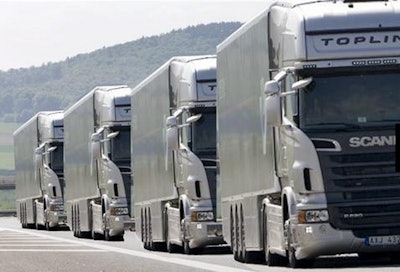 Scania testing semi-autonomous trucks in Japan in 2013.
Scania testing semi-autonomous trucks in Japan in 2013.I’ve been pounding you over the head about technology in this blog for the past couple of weeks. And I thought maybe it was time to put all of this in the context of a bigger picture: The future.
In a sense, every topic I hear discussed in the trucking industry today is –at its core – about the future of trucking. And if you had to boil all these discussions down to a single, concise sentence summing it all up, I’d propose this one: How are fleets and owner-operators going to make a living with all the changes the OEMs, the government, environmentalists, the geopolitical situation and the free market are pushing on us?
Without a doubt, this is a time of upheaval for the trucking industry. It is possible it will endure more change to the way we do business in the next 10 to 20 years than the last 50 combined. In fact, a strong argument could be made that the tidal wave of change began with diesel exhaust emissions mandates not long after the turn of the century and has only accelerated since then.
Understandably, when I talk to fleet executives, owner-operators and drivers, sooner or later the conversation turns to the uncertain future and angst about how that person, or their business will survive as those theoretical changes become reality.
So, let me interject a big jolt of good news into the conversation.
This week, the American Trucking Associations released a report on trucking’s outlook for the next 10 years or so. And guess what? The report is insanely positive! ATA predicts general industry growth of around 23 percent by 2025 and increase of freight revenues by an astounding 72 percent.
The takeaway here is obvious: No matter what happens inside the trucking industry, the freight is going to be there. That means the money is going to be there. And lots of it, it seems. So all the doom and gloom aside, trucking remains a vital national industry. And it appears its importance is only going to grow in the next decade.
That said, the next few years aren’t going to be a cakewalk. To prep you for the coming decade, here’s what you should expect to face:
The driver shortage. Unless a dramatic breakthrough occurs, this is a problem that is only going to get worse.
The technician shortage. If you think finding drivers is going be tough, finding people to work on trucks as their sophistication and technology grows in exponential leaps and bounds is going to be a nightmare.
Infrastructure. It’s a mess. I know this is a conservative-leaning industry, but our roadways aren’t up to handling transportation demands from 20 years ago. Not only do we need to get our current infrastructure back up to acceptable levels for today, we have to start planning and developing an infrastructure that will support new vehicles and the technologies that will make trucking work in the coming decades. That’s going to take foresight, leadership and revenue. Lots of revenue. As well as thoughtful investment strategies — both from government and the private sector.
Fuel prices. This is a weird moment right now: With Iraq going to hell in a hand basket and Israel kicking the hell out of Hamas, I keep waiting for sudden spikes in fuel prices to hammer us all. Hopefully that won’t happen. But rest assured, the long-term trends on petroleum fuel prices are not in your favor. Having a fuel strategy in place today is vital for your very survival in the future, whether that means surcharges, freight rate adjustments or alternative fuels or aggressive, MPG-focused vehicle specs.
Increased regulation. This is the new reality. Get used to it. I know it’s not fun, and I know you feel targeted and picked on. But as I’ve noted in past editorials, John Q. Public is scared of trucks and politicians know it. And now, technology is making it possible to enhance vehicle safety parameters and track driver performance in ways that were impossible a few years ago. Now that the government has those tools in hand, there’s no way it’s not going to use them to “make trucking safer,” or more “environmentally friendly,” or whatever else. I’m not saying give up. I’m not saying don’t fight for fairness and sensible rules. But successful fleets and owner-operators are going to be the ones that recognize increased regulation as a new business baseline and respond accordingly.
Vehicle technology. There is a school of thought championed by Sullivan & Frost’s Sandeep Karr (whom I respect greatly) that skyrocketing vehicle acquisition costs will spur a market for lower-cost, “disposable” trucks manufactured in places like China or India. That is a theory. Reality, at the moment, is that the combination of increased government regulations and technological advances are driving vehicle acquisition costs up at an alarming rate. And while the OEM argument is that eventually technology will mitigate some of these costs with fast ROIs and decreased operating costs, there is going to be a period of adjustment while these (1) technologies are perfected, (2) fleets and drivers learn to use them to their benefit and (3) economies of scale bring prices down (somewhat). At any rate, it’s a sure bet trucks are going to cost more in the future and that learning to use them as efficiently as possible is going to crucial for success (and profits).
Increased operating costs. Fuel prices, driver pay, regulations, insurance, vehicle costs, repair costs – everything bulleted above means that fleets are going to become more expensive to operate in the future. Good businesses (whether they be fleets or owner-operators) will develop strategies to offset those costs and remain profitable: passing costs on to customers, charging a premium for safety records and modern equipment, the aforementioned emphasis on efficient maintenance and vehicle operations and making technology work on your behalf are just a few possibilities to consider now, before you find yourself behind the curve and unable to react and respond to new market forces.
All of this is a lot to digest, much less deal with. But, again, if ATA’s predictions are correct, the money is going to be out there waiting on the fleets and owner-operators that figure out how to navigate and thrive in this new business climate.
Somebody is going to be moving freight in 2025. The only real question is will you be one of the people doing it?










